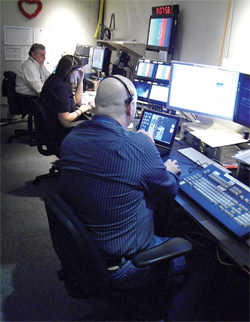Olympics: Low-Drama Graphics
VANCOUVER
From a graphics engineering perspective, doing more with less becomes more manageable with thoughtful design, increased processing power, the ever-increasing density of storage arrays, and great networking. That perfect storm struck Vancouver, and produced a relatively low drama Games for the NBC Olympics graphics department.
Even the character generators—Chyron HyperX3s—had been thoroughly vetted prior to the Games, something not always true in the past.
"We're using the HyperX3s after a successful run on 'Football Night in America' and The Super Bowl with it," explained Phil Paully, director of graphics engineering for NBC Sports. "Usually at an Olympics we end up testing whatever software we are using just two or three weeks before the Games."

Graphics playback room Paully said NBC had been working with Chyron over the last year on the product, and it's about six times faster than the box used in Beijing, with better processors, better memory, better clip playback and more.
CUTTING STEPS
"One of our specifications was that the HyperX3 had to go into the Apple XSan," Paully said. At the IBC, NBC had six Hyper X3s and nine Apple Mac Pros, all unified on the same Fibre Channel network.
Paully said this allowed NBC's creatives to cut a full four steps from the prior process needed to get a file from one machine to another. "From creation to distribution is one step for us now, and that's a big thing for us, Mac creation to Mac storage to distribution and playback through the Chyrons," said Paully. "Now, as soon as anything is done it goes on the SAN and [could be] grabbed off the SAN to go on air. That's the first time for this, and that's a big first."
In the past when elements were created on a Mac, they were saved locally, then put on a server, then the Chyron would have to grab it from the server, put it locally on its desktop, then manipulate it and integrate it within its finished graphic. Now when a user finished an element on a Mac the Chyron had it immediately, so all those extra steps and various database management functions that had to be done, had been cut down.
FASTER MACHINES, MORE STORAGE, LESS SPACE
A second big story from Vancouver was simple, yet powerful: big improvements in Mac Pros since the last Games. "The type of machines we are using now are so fleshed out," said Paully. "We used to have a 200 GB drive in it with one or two other drives, and we now load our Mac Pros with 4 TB of storage onboard in RAID 5 configuration, 12 gig memory, and high-end AJA Kona video cards."
Despite increases in processing power and storage, the physical size of the engineering portion of the graphics department shrank—in Vancouver, it was contained in two small rolling cases, rather than one of the old racks-in-a-box (RIB) where the machines were before. This was by design to keep costs down, said Paully. "And you really don't need that much space anymore—the RAIDs are smaller, in 12RU we are at 96 TB of storage."
Roughly half of that 96 TB of storage was filled up before they arrived in Vancouver, however. That's a lot of pre-build done in the months before the Games. It's also striking that in Beijing, the graphics rooms had managed with just 20 TB of storage.
Having so many elements done before the Games also explains why it was about as low-stress as an Olympics can be—this was mostly done by NBC staffers over the eight months or so before Vancouver, in addition to their routine work on other sports.
In the year before the Games, Paully estimated that perhaps 10,000 templates were made, of the different sports and all the athletes. "Canada gave us all their athletes on green screen, we have all our athletes on green screen, but we to have go to AP and other places to get headshots of other athletes," said Paully.
AND NETWORKING…
The graphics network at recent Olympics has also seen tremendous improvements. "If we didn't have a network we'd be dead in the water," said Paully. "You need the network, all of our Chyrons here talk to the Chyrons at the venues."
Paully said that the network part of the infrastructure had made real leaps in recent years: "It's much more straightforward, the ability to use metadata constructively within the SAN setting is there now."
NBC also kept a portion of various parts of the production in New York. For this broadcast, promos were partially done in New York, as was most map creation. "We also left our 3D work back in New York, for one person to just run an Autodesk Flint there and then use ProCast to send it here," said Paully. "Omneon's ProCast has been helpful here... we're moving 8 Gigs of clips in 15 minutes."
The horsepower behind the machines, the speed of the Internet, and the increased performance of the RAIDs would mean nothing without a crew ready to tap their potential. Paully cites the experience of the people working the equipment—about 20 at the IBC and 12 or so at the venues—and their familiarity with the workflow as another reason Vancouver was the calmest graphics area he had ever worked in at an Olympics.
Vancouver marked the fifth Olympics for Matt Celli, producer, Graphic Playback and Operations for NBC Sports, who cited both the equipment and the people as reasons why it was a smooth broadcast.
"The equipment and workflow have all been established and we checked everything out at 30 Rock in advance and used it for 'Football Night in America' and for the whole 2009 NFL season," said Celli. "We had fiber cards installed on the HyperX3s which hooked up right to the SAN which increased transfer speeds by 3 or 4 times."
Celli added that this was the first time where everyone had NBC Olympics experience. "Everyone was familiar with the playback and integration system that I set up… so even though the graphic look is different than previous Olympics, the implementation is similar, so there was a smaller learning curve for the playback operators as to how and where Chyron pages work and relate to each other."
Get the TV Tech Newsletter
The professional video industry's #1 source for news, trends and product and tech information. Sign up below.

